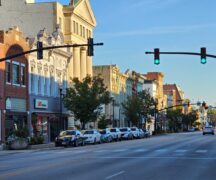By JAN LARSON McLAUGHLIN
BG Independent News
Every 25 years or so, downtown Bowling Green undergoes a transformation.
With the Heritage 1976 project, that meant some cosmetic improvements that spruced up the downtown. With the Heritage 2000 project, it meant putting infrastructure underground, adding brick banding on sidewalks and new street lights, and the start of assessing downtown properties to help pay for improvements.
On Tuesday afternoon, the next quarter-century project was announced in the Community Commons alley downtown by Mayor Mike Aspacher.
The 2025 project has been dubbed “Downtown Forward,” with a focus on respecting the city’s heritage and reimagining its future, Aspacher said. The ultimate goal is to attract and retain people in Bowling Green.
“Everything is on the table,” the mayor said. The project could encompass everything from physical improvements to changes in downtown marketing. “I really want the group to think broadly.”
Bowling Green’s downtown is the heart of the community, Aspacher stressed. A place for business, a place to gather as a community, a place that truly reflects Bowling Green.
“This project is worthy of our time, it is worthy of investment,” he said.
The Downtown Forward project will begin by identifying community priorities for the downtown, then developing detailed plans for implementation, he said.
“The collaborative approaches of the Heritage projects have been transformative for our community and I am excited to once again harness the capability, imagination, and hard work of our community to challenge ourselves to create opportunities to maximize the potential of this space for the next 25 years,” the mayor said.
Bowling Green was selected to participate in the Reimagining Rural Regions (R3) program with BGSU’s Center for Regional Development.
That means this time around, help has been enlisted from Bowling Green State University. Graduate and undergraduate students will be tasked with conducting community surveys and public forums to get input on the downtown.
“Our partnership with the Center for Regional Development will allow us to leverage economic and demographic data and facilitate public engagement with a spectrum of stakeholders to develop a placemaking strategy—and then identify the steps required to get there,” Aspacher said.
“They will do the heavy lifting with community engagement,” said Martha Woelke, Bowling Green community development administrator. The input from community members is vital, she said. “They are going to help us figure out what the downtown should be.”
Dr. Joe Whitehead, provost at BGSU, talked about the value of giving students experience with the project.
“This is an opportunity for them to roll up their sleeves and help Ohio,” Whitehead said.
Dr. Russell Mills, senior director for the BGSU Center for Regional Development, said citizens, business owners and property owners will be asked for input on the downtown’s future. There will be community education sessions, during which lessons will be shared of successes and pitfalls in other municipalities.
The Downtown Forward Committee will be led by Dick Newlove, who was involved in the Heritage 2000 endeavor. Back in 1976, the work was primarily cosmetic, he said. Then in 2000, the project scope was expanded.
Newlove envisions the 2025 project being even broader.
“I expect this will be even more along those lines,” he said.
Other members of the committee are: Mark Cassin, State Bank; Kati Thompson, BG Economic Development director and downtown business owner; Tim Emmerich, downtown property and business owner; Earlene Kilpatrick, retired SID and chamber director; Trevor Jessee, Civista Bank and member of board of public utilities; Chris Mowan, architect and member of city’s Historic Preservation Commission; Mark Remeis, real estate broker, downtown property owner and member of Planning Commission; Kate Sommerfeld, BG resident and VP of Community Relations at ProMedica; Amy Craft Ahrens, downtown business owner; and Nate Spitler, attorney. Student representatives from BGSU and Bowling Green High School have yet to be named.
In his State of the City Address earlier this year, Aspacher hinted at the 2025 downtown project.
“As we’ve updated planning documents over the past decade, the importance of the downtown to our community has emerged as a vital component time and time again. A strong downtown is a hallmark of a strong community,” he said.
Some of the possible ideas mentioned by the mayor during his address included:
- Improving aesthetics such as murals and public art along with attractive and comfortable outside environments;
- Improving public spaces including consideration of increasing sidewalk widths and enhancing alleys;
- Promoting upgrades such as façade improvements;
- Considering best uses of the right-of-way areas in and around downtown;
- Analyzing parking options that could be considered in tandem with new mixed-use development;
- Promoting and encouraging investment within the downtown.
The BGSU R3 program, launched in 2021, is an economic and workforce development- centered placemaking initiative that helps communities identify, enhance and build community assets to aid in talent attraction and retention.
The program provides the capacity to communities to conduct public engagement to develop placemaking plans. Additionally, BGSU graduate and undergraduate students work with each community to help plan and implement projects to enhance and build more livable spaces.
The project talks about “placemaking,” which can be defined as the planning, urban design and management of public spaces. It maximizes a local community’s assets, inspiration, and potential, with the intention of creating public spaces that promote people’s health, happiness, and well being. The goal is transforming places to live.
The R3 program is funded by the U.S. Economic Development Administration and the USDA Rural Development Rural Placemaking Innovation Challenge.



